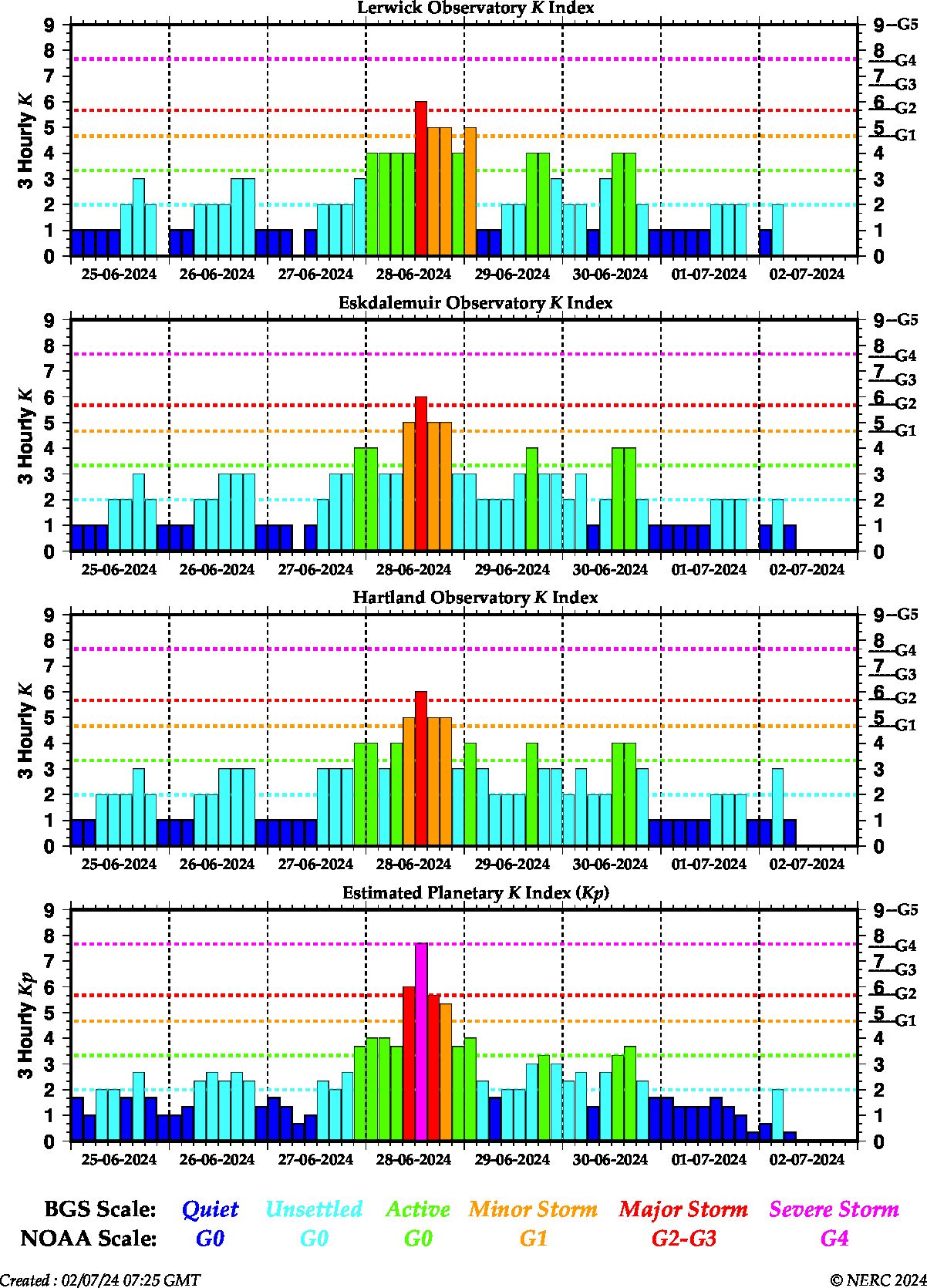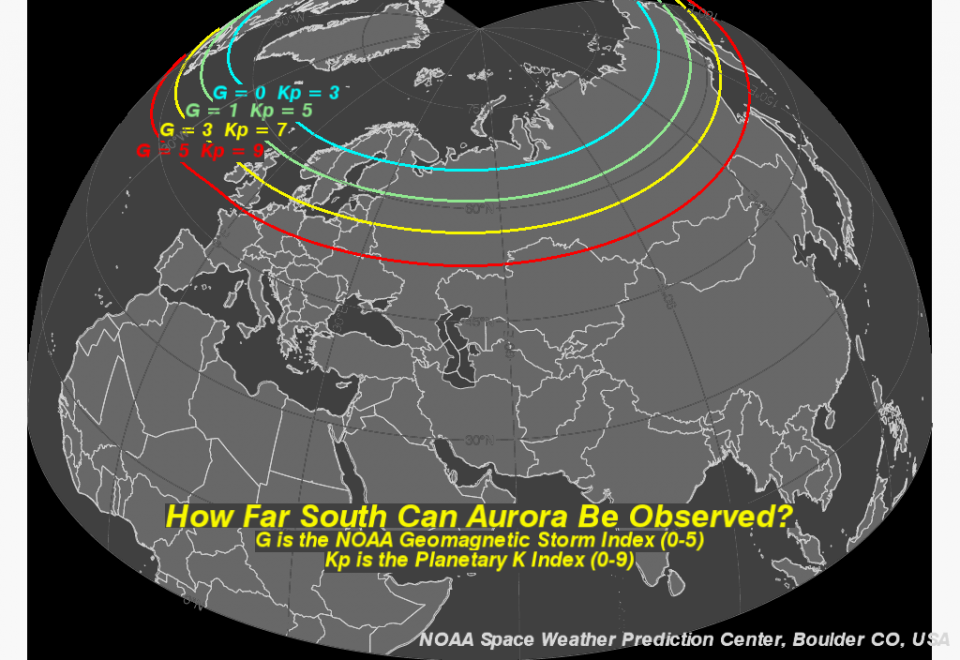Viewing Northern Lights in the UK
It is easier to see the northern lights (aurora borealis) in the UK than you might think. All you need is a dark place, a clear sky and very good timing!
The good timing is important as the northern lights are a result of a geomagnetic storm. These storms are short-lived periods of high geomagnetic activity where the Earth's magnetic field changes very quickly and strong electric currents flow high in the atmosphere.
Why does it happen?
The aurora is a consequence of activity on the surface of the Sun. Occasionally there are large explosions on the Sun, and huge amounts of charged particles are thrown out into space. These particles sometimes travel towards Earth where they are captured by the Earth's magnetic field and guided towards the geomagnetic polar regions.
On their way down these particles are slowed down by Earth's atmosphere, which acts as a shield. These charged particles collide with gas molecules in the atmosphere. The energy released in these collisions is given off as light.
What makes the colours?
When a charged particle collides with a molecule in the atmosphere the molecule becomes excited. The excited molecule is unstable and will give up its extra energy by emitting light.
The colour of the light depends on the molecules being excited. Like a sodium street light which gives off an orange light, the oxygen, nitrogen and other gases in the atmosphere have their own particular colours resulting in the range of blues, greens, yellows and reds observed in the aurora.
Where can you see it?
The auroral ovals represent the places on Earth where aurora occur most often and with greatest intensity. Under normal conditions the northern oval covers Scandinavia, Greenland, Alaska, Canada and Russia. The southern oval covers the Antarctic regions. With increasing geomagnetic activity the ovals widen and spread, so that during periods of high geomagnetic activity it becomes possible to see aurora further south in the UK.
When can I see it?
On average you might expect to see aurora in the far north of Scotland every few months, but less often as you travel further south.
Geomagnetic storms follow the 11-year solar cycle. The chance of big magnetic storms will be greatest around the years leading up to solar maximum and shortly afterwards. The current progress of the solar cycle is tracked by counting the number of sunspots seen on the Sun.
Generally, there are more magnetic storms around the equinoxes (March-April, September-October).
Advice for a budding aurora hunter
Most important! - Look out for a geomagnetic storm
Be on the look-out for geomagnetic forecasts predicting strong storm activity.
There are many ways to represent geomagnetic activity. One of these is the Kp index which ranks the variations in geomagnetic activity from 0 to 9, in 3-hour intervals. The larger the Kp index is, the stronger the storm and the further south the northern lights will be visible. The map on the right shows roughly where you might expect to see aurora based on Kp index levels.
This can also be expressed by the NOAA SWPC geomagnetic storm G-scale with G1 being a minor storm, and G5 an extreme event.
- See Current Global activity for up to date global geomagnetic activity
- See BGS Real-time estimated K and Kp for UK and global geomagnetic activity levels.
- The University of Lancaster run Aurora Watch which will alert you to strong geomagnetic activity in the UK.
For daily space weather forecasts: Follow @BGSspaceWeather
For occasional aurora alerts: Follow @BGSauroraAlert
Top tips for spotting the aurora
1. Clear, dark skiesThe aurora sits 100s of km up in the sky above the height of the clouds so you'll need cloud-free skies.
The sky also needs to be dark. Get away from streetlights. A bright full-moon will also wash out the light from faint aurora.
2. Location, Location, LocationAs the aurora usually sits north of the UK the further north you live in the UK the more chances you will have to see the lights. Those in the north of Scotland may see the aurora fairly often. While those who live in the south of England may see them rarely.
Try to have a clear view to the north. A coastal location or on top of a hill may be good options to try. During extremely strong displays the aurora might be overhead, or to the south of your location so have a good look around.
3. Good timingGenerally, the best chances of seeing the aurora is generally around the hours of local midnight, 10pm - 2am. However, the aurora may appear any time during the night depending on geomagnetic activity.
There is also a seasonal effect with the strongest magnetic storms tending to happen around the spring and autumn equinoxes.
4. Grab your camera!A camera is more sensitive than our eyes and will pick up the colour of the aurora. A faint display may appear white or grey to the eye but a long-exposure photo will pick up the greens, reds or purples.
Use a camera where you can manually set a exposure time. A lot of smartphones now have a night mode. Choose a long exposure time to collect the most light.
To avoid camera shake consider using a tripod.
5. Good luck!While scientists can give advance warning of incoming solar storms which might trigger the aurora, it is not possible to accurately predict a precise time or place where the northern lights will appear. There's always a bit of luck involved!




